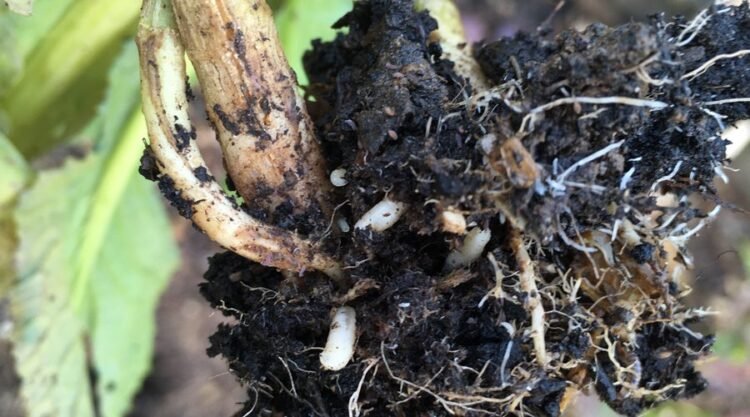Beautiful Plants For Your Interior
Cabbage Root Fly: Identification, Prevention, and Control

If you are growing brassicas in your garden, you may encounter one of the UK’s common garden pests, the Cabbage Root Fly. This small fly lays its eggs at the base of the plant, and the resulting larvae will tunnel into the roots, causing damage and stunting the growth of the plant.
Cabbage Root Fly: Identification and Control
Common Name:
Cabbage Root Fly
Latin Name:
Delia radicum
Plants Affected:
Cabbage Root Fly affects plants such as cabbages, cauliflower, Brussels sprouts, and other brassicas, oriental greens, swede, turnip, and radish.
Main Symptoms:
The main symptoms of Cabbage Root Fly infestation are slow growth, wilting, and death of plants.
Caused By:
Larvae of a fly.
Timing:
Cabbage Root Fly infestation is from April to September.
What is a Cabbage Rootfly?
If you’re growing brassicas such as cabbages, cauliflower, broccoli, and Brussels sprouts, you may have come across the cabbage root fly (Delia radicum). This pest is a common problem for gardeners and farmers alike, as it can cause significant damage to the roots of these plants.
The cabbage root fly lays its eggs at the base of the plant, and when the larvae hatch, they tunnel into the roots to feed on the plant’s nutrients. This can lead to wilting, stunted growth, and even death of the plant.
In addition to brassicas, the cabbage root fly can also affect other root vegetables such as swedes, turnips, and radishes. The larvae can cause the roots to shrivel and become discoloured, leading to nutrient deficiencies in the plant.
Preventing cabbage root fly infestations is key to protecting your plants. One effective method is to use a physical barrier, such as ‘fine mesh’ netting, to prevent adult flies from laying their eggs at the base of the plant. Crop rotation can also help, as the cabbage root fly prefers to lay its eggs in soil that has previously grown brassicas.
Overall, understanding the life cycle and habits of the cabbage root fly can help you take proactive steps to protect your plants and ensure a healthy harvest.
Symptoms
If your brassica plants, such as cabbages, cauliflower, and Brussels sprouts, are growing slowly, wilting, and dying, it could be a sign of an infestation of cabbage root fly. The larvae of the fly eat the roots of the plants, causing them to weaken and eventually die. Here are some symptoms to look out for:
- Plants grow slowly, wilt, and die as their roots are eaten
- Edible roots (Turnips & Swedes) can also be ‘tunnelled’
- Leaves of affected plants are edged ‘blue’ and often wilt
- Plants may show a ‘blueish’ tinge or yellowing of the leaves as if suffering from nutrient deficiency, which they are in effect as the damaged roots are unable to supply enough nutrients to the growing plant
To prevent and control cabbage root fly infestations, there are several methods you can use. Horticultural fleece or netting can be used to cover your plants and prevent adult flies from laying their eggs on the soil near the plants.
Another option is to use a ‘hoe’ to disturb the soil around the plants, which can prevent the flies from laying their eggs.
Cardboard collars can also be placed around the base of the plants to create a ‘barrier’ against the larvae. Mulching can help to deter the flies from laying their eggs in the soil as well, and companion planting can attract ‘natural predators’ to your garden to help control the fly population.
It’s important to monitor your plants regularly for signs of infestation, especially if you have seedlings or overwintering plants. If you do notice symptoms of cabbage root fly, take action quickly to prevent the infestation from spreading and damaging your entire crop.

Cabbage Root Fly: This Pest Looks Similiar to a House Fly
Management
To effectively manage cabbage root fly, there are several strategies you can use. These include:
- Cultural Control: Crop rotation is an effective way to manage cabbage root fly. Avoid planting ‘brassicas’ in the same location for at least three years. You can also use physical barriers such as fleece or mesh (as mentioned above) to prevent adult flies from laying eggs on the soil around the plants.
- Biological Control: There are several natural enemies of cabbage root fly, including parasitic wasps and ground beetles. You can encourage these natural predators by planting companion plants such as sweet alyssum and yarrow. You can also use nematodes as a biological control method.
- Chemical Control: Insecticides can be effective in managing cabbage root fly. However, it is important to use them as a last resort and follow the instructions carefully. Insecticides containing chlorpyrifos, thiamethoxam, and clothianidin are effective against this pest.
- Predators: Ground and Rove beetles are natural predators of cabbage root fly. You can encourage these predators by providing a suitable habitat, such as a hedgerow or wildflower strip, near the brassica crop.
Overall, a combination of these strategies is the most effective way to manage cabbage root fly. By using cultural control methods, encouraging natural predators, and using insecticides as a last resort, you can reduce the impact of this pest on your brassica crop.
Biology
The cabbage root fly, scientifically known as Delia radicum, is a common pest that affects plants in the brassica family, including cabbage, broccoli, and cauliflower. The adult fly resembles a ‘housefly’ in size and appearance. The male is about 1/4in (6 mm) long, while the female is slightly larger at 1/4 (6-7 mm). Adult flies emerge in April and feed/mate. The first generation of eggs is laid in May, mainly in the soil around the stems of brassica plants.
The larvae of the cabbage root fly are white, legless, and headless maggots that are up to around 1/2 in (10-15mm) long. They feed primarily on the roots of brassica plants, although they may also feed on the stem if there are no roots available. The larvae can cause significant damage to the plant, leading to wilting, stunted growth, and even death.
In summary, the cabbage root fly is a common UK pest that affects plants in the brassica family. The larvae of the flyare white, legless, and headless maggots that can cause significant damage to plants. There are several options available to control cabbage root fly, including physical barriers, natural predators, and chemical control.
